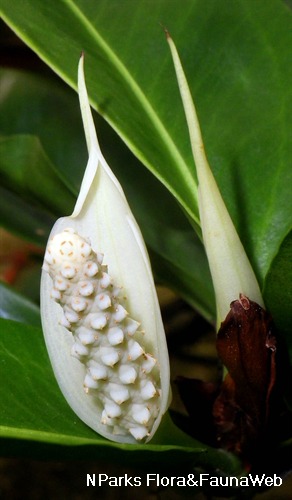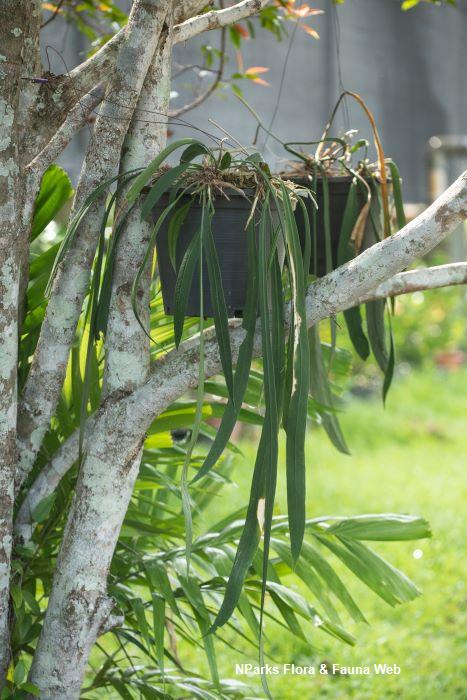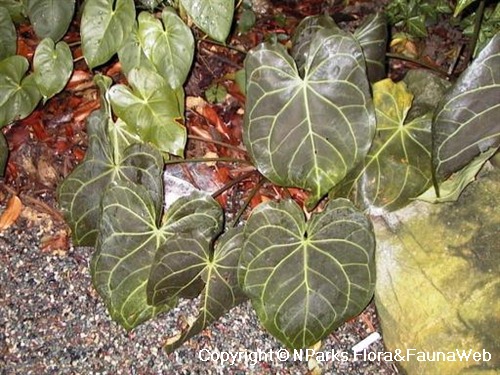
Back
Anthurium plowmanii Croat
| Family Name: | Araceae |
| Common Name: | Bird's Nest Anthurium, Anthurium Wave of Love, Wave of Love, 婆罗花烛 |
Name
Classifications and Characteristics
| Plant Division | Angiosperms (Flowering Seed Plants) (Monocotyledon) |
|---|---|
| Plant Growth Form | Shrub, Epiphyte |
| Lifespan (in Singapore) | Perennial |
| Mode of Nutrition | Autotrophic |
Biogeography
| Native Distribution | Brazil, Bolivia, Paraguay, Peru |
|---|---|
| Native Habitat | Terrestrial |
| Preferred Climate Zone | Tropical |
| Local Conservation Status | Non-native |
Description and Ethnobotany
| Growth Form | An epiphytic, herbaceous, erect shrub which grows up to 1.8 m tall. |
|---|---|
| Foliage | Leaves erect to spreading, measure up to 135 cm long and 55 cm wide. Shape elliptical to obovate, margins slightly rippled to wavy, apex acuminate, base truncate or attenuate. |
| Flowers | Inflorescence, erect; spathe lanceolate or ovate, measures up to 22 cm long and 8 cm wide, green and tinged with purple; spadix green to greyish, tinged with purple, measures up to 41 cm long and 2 cm wide, tapering; flowers squarish. |
| Fruit | Infructescence, berries, red, oblong, measures 1.2 cm x 0.6 cm, seeds 1-2 for each berry. |
| Etymology | The genus Anthurium means flower-tail, which refers to the tail-like spadix. |
Landscaping Features
| Desirable Plant Features | Ornamental Foliage |
|---|---|
| Landscape Uses | Interiorscape/ Indoor Plant |
Plant Care and Propagation
| Light Preference | Semi-Shade, Full Shade |
|---|---|
| Water Preference | Moderate Water, Occasional Misting |
| Plant Growth Rate | Moderate |
| Rootzone Tolerance | Well-Drained Soils |
Foliar
| Foliage Retention | Evergreen |
|---|---|
| Mature Foliage Colour(s) | Green |
| Foliar Shape(s) | Non-Palm Foliage (Obovate, Elliptical) |
| Foliar Apex - Tip | Acuminate |
| Foliar Base | Attenuate, Truncate / Square |
| Leaf Area Index (LAI) for Green Plot Ratio | 3.5 (Shrub & Groundcover - Monocot) |
Floral (Angiosperm)
| Flower & Plant Sexuality | Bisexual Flowers |
| Flower Colour(s) | Green |
|---|---|
| Flower Grouping | Cluster / Inflorescence |
| Flower Location | Axillary |
| Inflorescence Type | Spathe & Spadix |
| Flower Colour(s) Remarks | Purple tinge. |
Fruit, Seed and Spore
| Mature Fruit Colour(s) | Red |
|---|---|
| Fruit Type | Fleshy Fruit |
| Seed Quantity Per Fruit | Few (1-5) |
Image Repository
Others
| Master ID | 382 |
|---|---|
| Species ID | 1678 |
| Flora Disclaimer | The information in this website has been compiled from reliable sources, such as reference works on medicinal plants. It is not a substitute for medical advice or treatment and NParks does not purport to provide any medical advice. Readers should always consult his/her physician before using or consuming a plant for medicinal purposes. |


.jpg)
.jpg)
.jpg)



